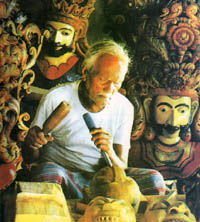|

Traditional Mask Carving has a long tradition
in the south and south-western coastal areas of Sri Lanka. According to the tradition of Ariyapala Gurunnanse, masks were
originally cut from the stem of the "ding" palm tree, which seams the rivers and lakes in the hinterland of Ambalangoda. Eventually
it was realised that the masks were not lasting long enough, so the artists changed to using the wood of the Kaduru-tree (nux
vomica). This is a comparatively light, but durable wood, which is easy to carve. The tools used by the artists have not changed
much over time, although they are of a better quality nowadays
Enter subhead content here

Stage 1
First the wood is cut to the approximate size. The log is marked out with the relative dimensions of the mask and the carving
proceeds in various steps
|

